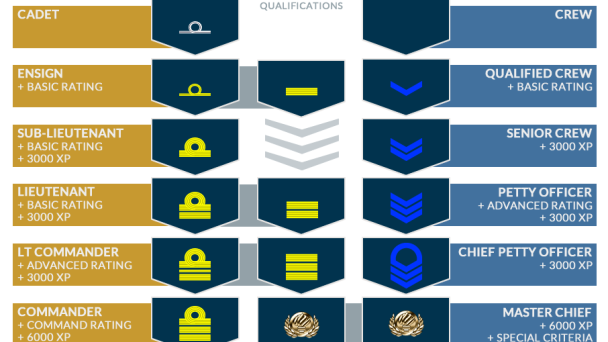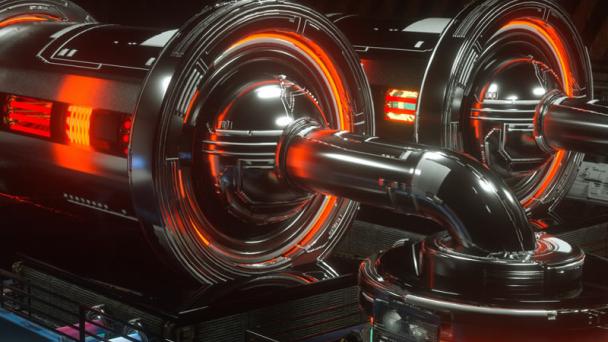August 2025
Text Teaser Career Track
Your choice of career track reflects your persona in the simulated universe. As you gain ratings and experience points (XP) these are automatically added to your online profile.
You can swap between career tracks at any time without affecting your accumulated ratings and XP.
Virtual careers aren't required to enjoy simulator missions but they add to the experience.
Text Teaser Join 2
Missions require different mixes of skills across navigation, tactical, engineering and science.
Surrounding yourself with a crew that has a mix of interests and skills means you’ll always be mission ready.
Once you see an area of tech that interests you, you can sign up for free to find out more about it.
Single Teaser Crew 2
Text Teaser Academy 1
A simulator requires a little more complexity to be realistic, but systems are highly intuitive. The Academy has everything you need to get mission ready.
Short video-based courses introduce you to Endeavour’s tech and how to use it.
Each course is based on a particular ship system and once completed you’ll be ‘rated’ on that system, which will be displayed in your profile.
Each mission displays the ratings needed to complete it, so you and your crew know exactly if you’re ready for a mission.
Science Tech
Sensor systems are used to provide analysis of the ship's operating environment. Effectively the the vessel's eyes and ears, sensor systems are vital to core operations.
Applications
Sensor systems are used across a range of key vessel systems including:
Helm
Sensor systems are used to fix the vessel's position in space in order to ensure effective navigation
Tactical
Passive sensor systems are used to determine the location and range of tactically-significant objects around the vessel and to assist the targeting and deployment of weapons and countermeasures.
Analysis
Active sensor systems are used to provide detailed analysis of objects encountered in space such as other vessels.
Exploration
A range of sensor systems including drones are used to analyse spatial and planetary phenomenon for scientific advancement and to potentially assist in the search for first contact with other civilisations.
Long-Range Sensors
Long range sensors are used to analyse distant stellar phenomenon and to support navigation. Long-range sensors primarily use radio telescope equipment.
Near-Range Sensors
Near-range sensors use a range of passive and active equipment to analyse the vessel's immediate operating environment within star systems. This typically includes other vessels or smaller Astronomical Objects (AOs) or phenomenon. When the vessel's on-board sensors are augmented by drones, larger objects such as planets can also be mapped.
Passive Systems
Passive sensor systems detect EM radiation emitted by other vessels, Astronomical Objects (AOs) or phenomenon.
Analysis of the detected EM can provide insights into its origin or purpose (for example whether the EM is for communications, scanning or tactical purposes).
Passive sensors have the advantage of not requiring the emission of any EM (as is required for active scans) which minimises the chances of being detected by another vessel, which is highly useful in tactical applications.
Passive systems also typically operate at much longer ranges than active systems.
EMDAR
EMDAR is used for the initial detection of objects in space. EMDAR is primarily a tactical system although once an object is tracked by the system analysis of its EM emissions can provide additional insights well before active systems can be effective.
Peak Frequency Analysis (PFA)
(PFA) provides a detailed analysis of EM detected closer to the vessel. This analysis can provide guidance on the direction of the EM source as well the extent to which the EM may have been targeted at the vessel.
The frequency distribution and amplitude within the detected EM can provide insights into its purpose, for example whether it is for communications (and the type of communications), scanning or tactical purposes.
Active Systems
Active sensor systems emit EM (as a scan) and analyse its reflection, diffraction or absorption to build a 3D visualisation of the object and form conclusions about its composition.
Different active sensor types provide different levels of information and are typically grouped into two major categories, depending on the frequency and/or intensity of the scans required.
Low Power Active Systems
Low power systems use lower frequency EM (typically within the radio and infrared spectrum bands).
Simple Location/Identification Scans
A Simple Location/Identification (SLI or 'sly') active scan is used to identify the location of non-AO objects within range of the scanning vessel (up to 3000 GUs). A list of objects of interest is displayed which can then be targeted by the operator for further scanning and/or tracking.
Spectral Composition Analysis (SCA)
Spectral Composition Analysis (SCA) uses the same low frequency EM scans for longer periods to build a 3D visualisation of the object. Analysis of the reflection, diffraction and absorption of the scan is used to assess the composition of the scanned object.
The system can typically determine the material type (metallic, mineral, organic, gaseous, liquid) and key datapoints such as density, temperature and even component elements.
Once a SCA scan has been completed to a minimum fidelity it is possible to overlay the approximate location of EM output onto the object to assist with analysis.
High Power Active Systems
High power systems use higher frequency EM (typically within the ultraviolet and ionising spectrum bands) to provide analysis if the interior of objects. The frequencies used by higher power systems makes it more likely that a scan might be mistaken for hostile activity such as weapons fire.
Spectroscopic Structural Analysis (SSA)
Spectroscopic Structural Analysis (SSA) utilises higher frequency scans to penetrate the exterior of the scanned object and provide insights into the object's interior.
The relative density of materials encountered by the scan as it penetrates through the object can indicate whether the object has interior spaces, wether those spaces have an atmosphere of some kind and whether organic objects of any significant size (such as lifeforms) are present. AI-assisted analysis is used to provide insights to the operator on the interior composition of the scanned object.
Tactical Tech
Endeavour’s mission is one of exploration and discovery. In an unknown and distant environment however, the vessel must be able to defend itself if needed. There are already known threats to the ISDC’s mission from other terrestrial deep space programs and potentially other alien species. Even under the best circumstances, first contact in some completely new language risks misunderstandings that might escalate to conflict.
In the vastness of space, the ability to detect and counteract a potential threat before it can inflict harm is vital. This can be achieved with asynchronous tactical capabilities: the ability to track without being detected or to deliver combat payloads while outside the weapons range of the threat. Ideally, both.
Tactical Operating Environment (TOE)
The Tactical Operating Environment (TOE) is the area of space surrounding the vessel that requires active management, due to possible navigational hazards or tactical threats. The TOE is defined by the range of tactical sensors, which locate and track non-mapped objects.
Maintaining awareness of the TOE is the primary task of the vessel’s tactical team. This includes detection and tracking of unmapped objects around the vessel and if necessary developing firing solutions to any object deemed a threat to the vessel’s safety.
More Tactical Operating Environment
Weapons Systems
Of all the technology recovered from extra-terrestrial vessels, very little has been weapons technology. Recovered technology has been used to develop high-powered railguns and work continues on the development of beam weapon systems.
There is some evidence to suggest that extra-terrestrial tactical systems utilise beam weapons and protective force fields designed to protect against them. While technologically more sophisticated, beam weapons likely lack range compared to torpedoes, while shields designed for beam weapons may not be fully effective against kinetic weapons.
It is likely that terrestrially-launched threats such as those from rival programs will utilise similar weapons systems to the ISDC.
Torpedo System
The vessel's primary armament is based around a system of railgun-launched self-guided missiles known as torpedoes. Being guided, these have the advantage of being accurate over far greater distances (up to 15 million kilometres) than beam weapons. The torpedo system is designed as a multiple-purpose tactical delivery platform.
Countermeasures
A range of countermeasures provide the vessel with defence against incoming fire.
Phalanx CIWS
The Phalanx Close-In Weapons System (CIWS) is a series of rapid-firing intermediate-power beam weapons that create a cloud between the vessel and incoming missiles or torpedoes.
Decoys
Decoys may be launched that generate false EM profiles to lure incoming torpedoes off target.
Electronic Warfare
Electronic Warfare (EW) involves the use of the EM spectrum to interfere with a threat's communications, scanning and tracking systems.
Engineering Tech
Engineering systems are responsible for the core operations of the ship, including power generation, propulsion and life support.
Engineers are expected to keep the power on and systems operational even as the ship takes combat damage or grapples with unexpected phenomena.
Power Generation
Endeavour relies on a magneto-inertial fusion reactor as the main source of electrical power, which is used to run everything from the ship's engines to weapons and life support.
Power Distribution Network
The Power Distribution Network (PDN) is highly redundant network of power distribution nodes and conduits gets power to where it needs to be, including the ability to route around damage.
The PDN is also able to monitor the health of connected ship systems, alerting crew to malfunction or damage and providing diagnostic information to guide repair crews.
Propulsion
The vessel's main engines provide propulsion at up to 20% the speed of light for travel within star systems. An alien-derived Faster-Than-Light (FTL) drive provides much faster relativistic speeds for travel between star systems.
Main Engines
The vessel uses Magnetoplasma Impulse Engines (MIE) which use plasma accelerated by powerful magnetic fields to propel the ship at subluminal speeds - a maximum of 20% the speed of light (60,000Km/sec).
FTL Drive
Faster-Than-Light (FTL) travel is made possible by an alien derived device capable of generating powerful gravimetric fields, which "warps" space to bring distant points much closer to the ship, effectively accelerating the ship's velocity to many times the speed of light.
Teaser Academy
Text Teaser Careers 2
A real career in deep space would take place over decades, but with immersive sci-fi a virtual career is much more accessible. Training courses take minutes rather than weeks and years of experience can be gained within hours.
Achieving system ratings through our online Academy provide the skills you need to join missions. Completing missions gives you experience points (XP) based on time spent in the simulator and complexity, advancing your virtual career.
Keep track your achievements through your online profile.








